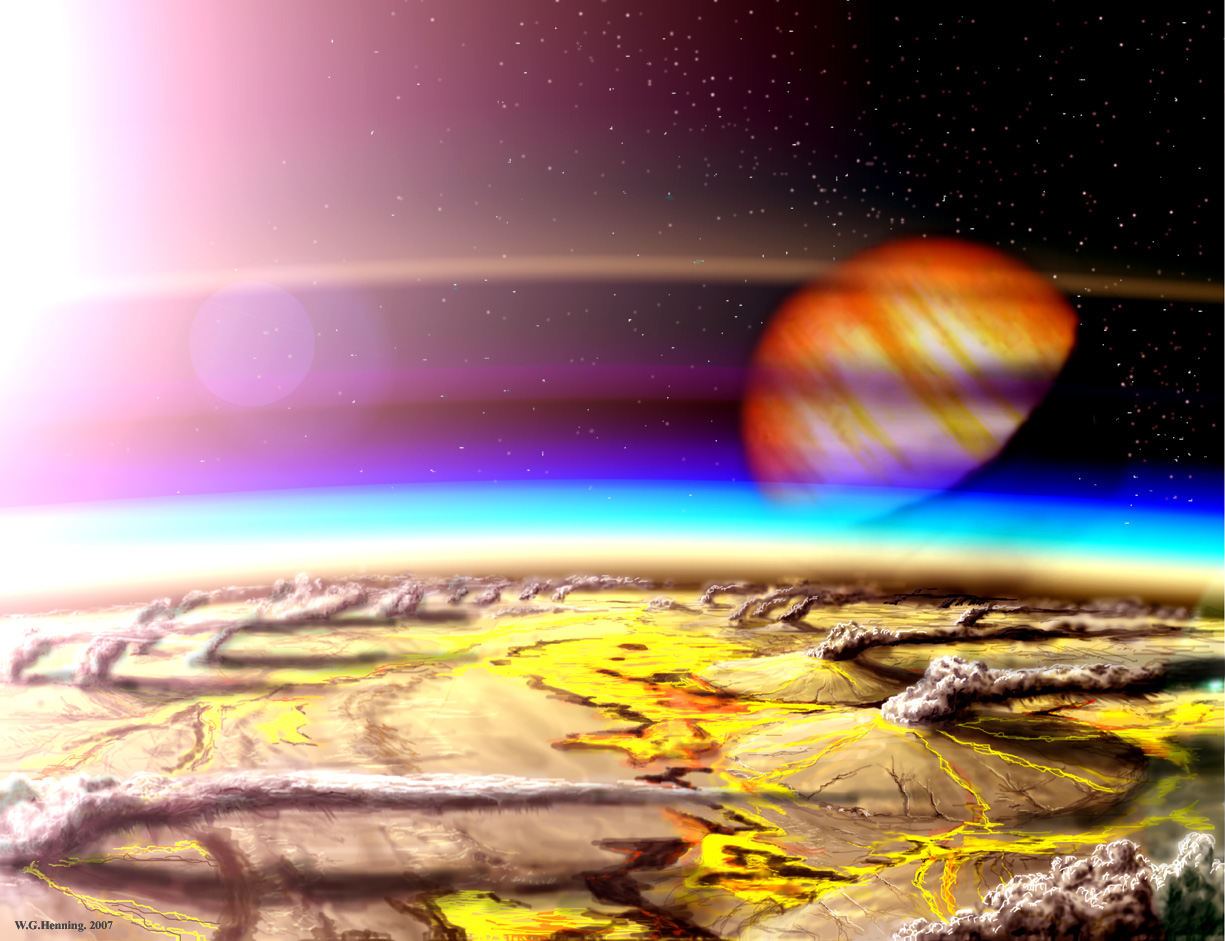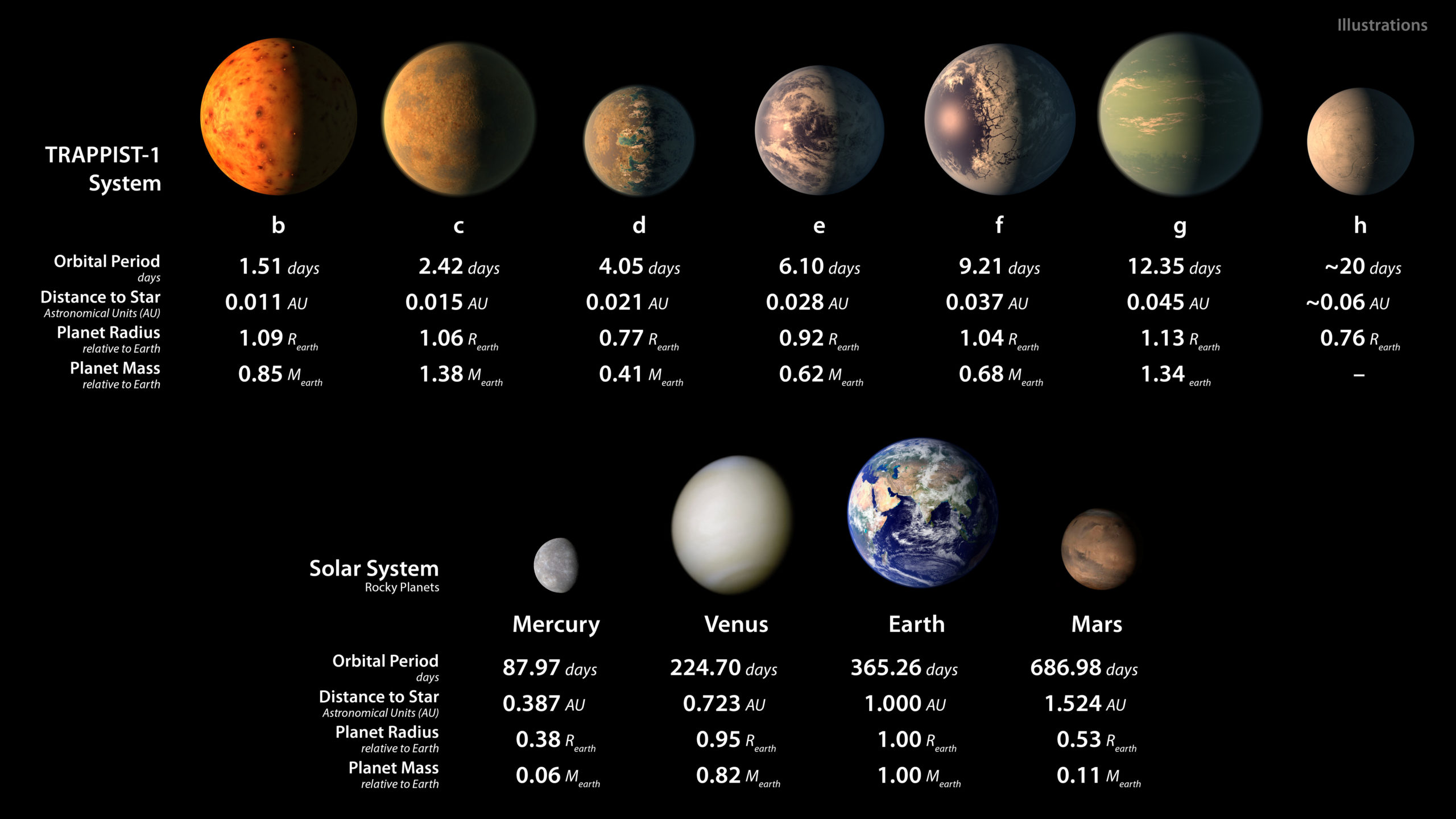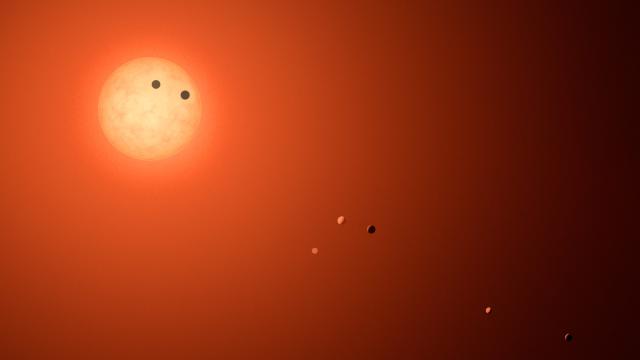Less than a week ago, the citizens of Earth were introduced (technically, re-introduced) to a star system 39 light years away hosting seven Earth-sized exoplanets, three of which lie squarely in the habitable zone. As if that wasn’t exciting enough, researchers are now suggesting that a fourth of the TRAPPIST-1 planets might be habitable, too — if we stretch our imaginations a bit.
Artist’s concept of 7 Earth-sized planets orbiting TRAPPIST-1. Image: NASA
New models out of Cornell University suggest that the so-called habitable zone, where rocky planets can support liquid water and perhaps life, might be larger than previously assumed, if we consider volcanic hydrogen (H2) as a potential climate-warming greenhouse gas. Not only could planets whose atmospheres are warmed by H2 (instead of CO2) remain habitable in more distant orbits, certain fingerprints of life might be more readily visible in their atmospheres.
If the study’s findings hold up, then TRAPPIST-1h — the outermost of the recently-discovered TRAPPIST planets, currently imagined to be an ice world — might be capable of supporting oceans. “The TRAPPIST planets are really cool,” Ramses Ramirez, lead author on the new study published today in The Astrophysical Journal Letters, told Gizmodo. “Certainly three are in the traditional habitable zone, but with hydrogen, a fourth planet might be in it.”
Traditionally, astronomers have defined the habitable zone in terms of two molecules inextricably linked to life on Earth: Carbon dioxide and water. By this definition, the habitable zone’s outer edge is where energy from the Sun is so scarce that CO2 freezes out, like it does on Mars. The inner edge, meanwhile, is where a planet’s average temperature is above the vapour point of water. A little too hot, and the oceans will boil away, triggering a runaway greenhouse effect. This may have happened, aeons ago, on Venus.
But in the billions upon billions of star systems in our galaxy alone, should two greenhouse gases, CO2 and water always be our litmus test for habitability? Perhaps not. “Additional greenhouse gases could further extend the [habitable zone],” Ramirez and study co-author Lisa Kaltenegger write in their paper.

Artist impression of a habitable planet in the volcanic Hydrogen habitable Zone. Image: W. Henning, NASA Goddard
One of those additional gases is hydrogen. Years back, scientists proposed that planets with thick, H2-rich atmospheres might stay warm enough to support liquid water out to the incredible distance of 10 astronomical units (AU) — as far away as Saturn. But can a rocky world maintain an H2-rich atmosphere for the hundreds of millions to billions of years needed for life to evolve? H2, after all, is an extremely light molecule, prone to fizzling off into space.
To find out, Ramirez and Kaltenegger ran climate models for hypothetical planets orbiting stars that ranged in temperature from 2600 to 10,000 Kelvin (our sun averages about 5800 K), with atmospheric H2 concentrations ranging from one to 50 per cent. (The rest of the atmosphere was made up of CO2 and water vapour.) The results were encouraging. H2-rich atmospheres, the researchers found, can expand the habitable zone by 30 to 60 per cent — assuming new hydrogen is constantly being added to the atmosphere to replace what’s lost.
That could happen if hydrogen gas was escaping from the mantle, or outgassing, via volcanoes. Scientists believe Mars was a leaky faucet in the first half billion years of its history, outgassing loads and loads of hydrogen. Larger-than-Earth-sized rocky planets, the new study argues, might favour even longer periods of hydrogen gas release due to a variety of factors, including higher gravity and stronger magnetic fields.
In our solar system, adding volcanic hydrogen-heated planets to the mix would expand the habitable zone to 2.4 AU, into the asteroid belt between Mars and Jupiter. “Where we thought you would only find icy wastelands, planets can be nice and warm — as long as volcanoes are in view,” Kaltenegger said.
Excitingly, it might be easier to detect “biosignatures” in H2-rich atmospheres, compared with more Earth-like ones. “H2 is a very light gas — mix it with CO2 and water vapour, and you’re gonna puff up the atmosphere,” Ramirez explained. “If you have a mission trying to detect life, this will make it easier.”
Astronomers hope to start observing the atmospheres of nearby rocky planets for signs of life with the launch of the James Webb Space Telescope in 2018.

Image: NASA
Ramirez and Kaltenegger’s models have implications for everybody’s new favourite cosmic real estate, TRAPPIST-1. Whereas conventional habitable zone definitions place three of the system’s Earth-sized planets in the liquid water sweet spot, a volcanic hydrogen habitable zone might bring the outermost planet, “h”, into the fold, too. “It’s really right on the border, if not within it,” Ramirez said. “It’s something we need to look into.”
Julien de Wit, an MIT exoplanet researcher and co-author on TRAPPIST-1 study that made international headlines last week, was very excited at the possibility.
“Such a study is perfectly timely as it further highlights the needs for observational constraints to refine our understanding of habitability,” de Wit told Gizmodo in an email. “It is really exciting to know that we are at the verge of revisiting our understanding of/perspective on these concepts underlying fundamental questions such as ‘are we alone?’”
Ramirez agrees. “There has been too much of a focus, not just on CO2 and water, but on Earth-centric [concepts in general],” he said. “It’s naive to think other [habitable] planets would be just like the Earth — we just don’t know.”
“Maybe life on other planets is very similar to Earth, but maybe not. And if not, we should be open to other possibilities.”
